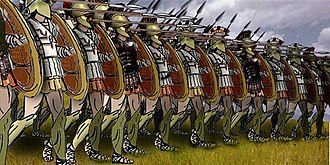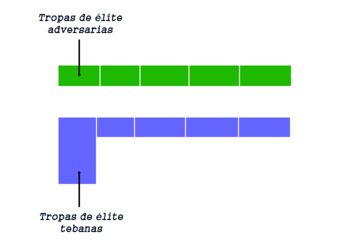Phalanx
The phalanx was a tactical war organization created in Ancient Greece and later imitated by various Mediterranean civilizations. By extension, ancient authors usually call any army that fights in a single line of combatants very close to each other, in the style of the classical phalanx, which thus formed with a depth of between 8 and 16 warriors. The term is of Greek origin, φάλαγξ (phálanx), which was used for the defensive formation used by the hoplites, who constituted the classical phalanx.
The term phalanx in the Archaic Period
The term phálanx is ancient in the literature of Ancient Greece. It abounds in Homer and, although less frequently, is found throughout this period.
The term appears to come from the Indo-European root *bhel, meaning "to swell, grow", with a nasal suffix -ng. Ancient etymology referred primarily to a solid, elongated segment or fragment of any material, sometimes cylindrical in shape. In the military field it is related to its rectangular shape, referring to "segments" of the army. However, it cannot be concluded from the uses of the term and its mere existence in archaic literature that the Homeric and Archaic phalanges were an "elongated segment". In the Iliad the term phálanx appears 34 times and in all but one, in the plural.
In other literary sources, in the span of two centuries the term only appears four times: in Hesiod, in Theogony 676 and 935; in Tirteo fr.12.21, and in Mimnermo 14.3. In these mentions the term is in the plural and "does not refer to a specific unit, with a determined number of troops or a specific tactical formation, but rather it is a broad way of designating the troops".
In the epic and the lyric, the phalanxes are units that evolve with speed and initiative on the battlefield, compared to the cohesive unit, in closed formation and in ranks, of classical times.
The term phalanx in classical times
There is no citation from the 5th century BC. C to this term, neither in the singular nor in the plural as a military formation. Herodotus only mentions it once in its etymological sense, and the rest of the authors do not include it in its military meaning.
The first to designate the phálanx, up to 60 times, as a heavy infantry formation is Xenophon, and he does so in the singular. In general, the Athenian writer calls it phálanx the body of Greek heavy infantry soldiers formed in lines, which normally occupies the center of the battlefield and plays the most representative role in combat.
The phalanx of classical times
The classical phalanx was made up of hoplites. In a first stage, from the 7th century B.C. C. until the Peloponnesian War at the end of the 5th century B.C. C., the phalanx is made up exclusively of citizens of the Greek polis who fight to defend their city and their social status. The idea of the phalanx itself is not just military, but is an expression of community among equals. Whoever wanted to stand out in combat by leaving the line endangered his life by not having companions to protect his sides and, at the same time, endangered the phalanx by leaving a gap through which the line could be broken.. There was no room for heroic individual combat in the style of those narrated by Homer.
Being a hoplite was also an honor, since it implied an important social status in the polis and implied a certain expense for the citizen, who had to pay for his equipment. Only the very rich could afford a full iron defensive kit, and possibly those in the back ranks were those who couldn't afford quality full kits.
During the Peloponnesian War, the phalanx lost much of this social significance as it was necessary, due to the long duration of the wars, to recruit mercenaries, warriors who fought for a salary. This is how the light infantry appears, generically known as peltastas, who fought lightly armed or used slingshots, bows, etc. to harass the enemy and whose name derives from pelta, a characteristic oval-shaped shield.
In what we can consider the military end of Classical Greece, the exclusively hoplitic model was definitively crushed when the strategos Epaminondas, in command of the army of Thebes, defeated the classical hoplitic phalanx of Sparta with a numerically inferior army in Leuctra (371 BC) Epaminondas achieved this success thanks to his great tactical innovation, which consisted of arranging the bulk of the phalanx, made up of hoplites, at an oblique angle, from right to left of the field, and concentrating on the left a group of hoplites fifty men deep that broke the line of the enemy phalanx, much shallower. Thanks to the angled formation, the Theban phalanx overflowed the opponent at that point and wrapped it up. This model was called "hammer".
The cavalry and light infantry were of great importance when defending the flanks of the square that produced the rupture, so as not to be surrounded by the enemy before contact and contributed to encircle it afterwards.
Philip II of Macedon
The next (and extremely important) innovation was carried out by the Macedonian king Philip II, father of Alexander the Great, around the middle of the 4th century B.C. C. Hostage in Thebes after the victories of Epaminondas over the main Greek cities, Philip learned the Theban tactics and returned to Macedonia willing to improve them. The soldier or pezhetairoi thus came to carry a 6 m long spear, the sarissa that he had to handle with both hands, and to lighten the weight of the shield, which had to be hung from the neck. From the front ranks thus issued a forest of spears that skewered anything that came near, from infantry to elephants.
In addition, Philip changed the structure of the phalanx, grouping the men into independent squares of 16 hoplites in front by 16 in depth (256 men) called syntagmas and each phalanx was divided into two wings of 32 syntagmas each, that is, 16,384 men in total, under the command of a stratego. This division allowed greater flexibility in combat and was the one that enabled his son Alexander to conquer from the Anatolian peninsula to northern India, with cavalry and light infantry becoming very important in encircling movements, although the phalanx continued to constitute the bulk of the war. from army.
It did, however, have its shortcomings: the Macedonian phalanx only operated well on level ground, and despite its solidity, it was highly sensitive to attack from the flank or rear.
Roman Legion
Every tactical formation has its end. The one with the phalanx was the appearance of the Roman legion, much more flexible, since the first did not have good mobility. The Macedonian-style phalanx of Pyrrhus, King of Epirus, invaded Italy in the 3rd century BCE. C. and defeated the first Roman legions, but the legion withdrew from the field with few losses. Later during that century and II a. C., Rome defeated Carthage, which had mercenary phalanxes as part of its army, although they were not its main force. Finally, in the battle of Pydna, next to Mount Olympus in Greece, year 168 a. C., the Roman legion completely crushed the phalanx of King Perseus, showing the obsolescence of this formation, widely imitated throughout the Mediterranean.
In reality, the phalanx was managing to prevail over the legion in a close combat, where the legionnaires were unable to break through the pikes; however, as the Romans fell back, they accidentally led the phalanx onto uneven ground, which coupled with the "tug of war" of combat created small holes in the forest of spears of the phalanx. The Roman general took advantage of the flexibility of the legionaries, capable of fighting in small units or alone, to exploit these gaps, breaking the phalanx formation. Had they not entered difficult terrain, it is very possible that the phalanx would have won.
The final point was given by the Battle of Magnesia, in which King Antiochus III was defeated by Lucius Cornelius Scipio. However, the battle that is now recognized as the final defeat of the phalanx, Cynoscephalus, enjoys such a reputation somewhat exaggeratedly. Common sense indicates that, given and known the strategies and locations of both armies, the Roman victory was just a stroke of luck for the Latin side: the condition of the Macedonian army (phalanx) was not the main cause of their defeat, but the lack of speed of the left flank to form, place from which the Romans opened a fatal gap to win the battle.
Contenido relacionado
Corvette
Moment
France



